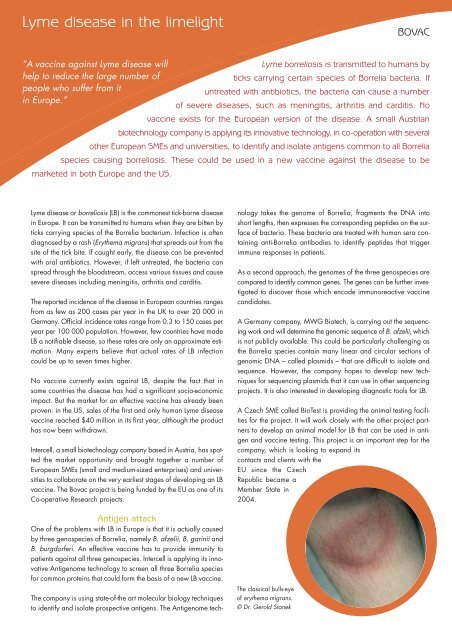Co-operative Research projects for SMEs - European Commission ...
Co-operative Research projects for SMEs - European Commission ...
Co-operative Research projects for SMEs - European Commission ...
You also want an ePaper? Increase the reach of your titles
YUMPU automatically turns print PDFs into web optimized ePapers that Google loves.
Lyme disease in the limelight<br />
“A vaccine against Lyme disease will<br />
Lyme borreliosis is transmitted to humans by<br />
help to reduce the large number of<br />
ticks carrying certain species of Borrelia bacteria. If<br />
people who suffer from it<br />
untreated with antibiotics, the bacteria can cause a number<br />
in Europe.”<br />
of severe diseases, such as meningitis, arthritis and carditis. No<br />
vaccine exists <strong>for</strong> the <strong>European</strong> version of the disease. A small Austrian<br />
biotechnology company is applying its innovative technology, in co-operation with several<br />
other <strong>European</strong> <strong>SMEs</strong> and universities, to identify and isolate antigens common to all Borrelia<br />
species causing borreliosis. These could be used in a new vaccine against the disease to be<br />
marketed in both Europe and the US.<br />
Lyme disease or borreliosis (LB) is the commonest tick-borne disease<br />
in Europe. It can be transmitted to humans when they are bitten by<br />
ticks carrying species of the Borrelia bacterium. Infection is often<br />
diagnosed by a rash (Erythema migrans) that spreads out from the<br />
site of the tick bite. If caught early, the disease can be prevented<br />
with oral antibiotics. However, if left untreated, the bacteria can<br />
spread through the bloodstream, access various tissues and cause<br />
severe diseases including meningitis, arthritis and carditis.<br />
The reported incidence of the disease in <strong>European</strong> countries ranges<br />
from as few as 200 cases per year in the UK to over 20 000 in<br />
Germany. Official incidence rates range from 0.3 to 150 cases per<br />
year per 100 000 population. However, few countries have made<br />
LB a notifiable disease, so these rates are only an approximate estimation.<br />
Many experts believe that actual rates of LB infection<br />
could be up to seven times higher.<br />
No vaccine currently exists against LB, despite the fact that in<br />
some countries the disease has had a significant socio-economic<br />
impact. But the market <strong>for</strong> an effective vaccine has already been<br />
proven: in the US, sales of the first and only human Lyme disease<br />
vaccine reached $40 million in its first year, although the product<br />
has now been withdrawn.<br />
Intercell, a small biotechnology company based in Austria, has spotted<br />
the market opportunity and brought together a number of<br />
<strong>European</strong> <strong>SMEs</strong> (small and medium-sized enterprises) and universities<br />
to collaborate on the very earliest stages of developing an LB<br />
vaccine. The Bovac project is being funded by the EU as one of its<br />
<strong>Co</strong>-<strong>operative</strong> <strong>Research</strong> <strong>projects</strong>.<br />
Antigen attack<br />
One of the problems with LB in Europe is that it is actually caused<br />
by three genospecies of Borrelia, namely B. afzelii, B. garinii and<br />
B. burgdorferi. An effective vaccine has to provide immunity to<br />
patients against all three genospecies. Intercell is applying its innovative<br />
Antigenome technology to screen all three Borrelia species<br />
<strong>for</strong> common proteins that could <strong>for</strong>m the basis of a new LB vaccine.<br />
The company is using state-of-the art molecular biology techniques<br />
to identify and isolate prospective antigens. The Antigenome tech-<br />
BOVAC<br />
nology takes the genome of Borrelia, fragments the DNA into<br />
short lengths, then expresses the corresponding peptides on the surface<br />
of bacteria. These bacteria are treated with human sera containing<br />
anti-Borrelia antibodies to identify peptides that trigger<br />
immune responses in patients.<br />
As a second approach, the genomes of the three genospecies are<br />
compared to identify common genes. The genes can be further investigated<br />
to discover those which encode immunoreactive vaccine<br />
candidates.<br />
A Germany company, MWG Biotech, is carrying out the sequencing<br />
work and will determine the genomic sequence of B. afzelii, which<br />
is not publicly available. This could be particularly challenging as<br />
the Borrelia species contain many linear and circular sections of<br />
genomic DNA – called plasmids – that are difficult to isolate and<br />
sequence. However, the company hopes to develop new techniques<br />
<strong>for</strong> sequencing plasmids that it can use in other sequencing<br />
<strong>projects</strong>. It is also interested in developing diagnostic tools <strong>for</strong> LB.<br />
A Czech SME called BioTest is providing the animal testing facilities<br />
<strong>for</strong> the project. It will work closely with the other project partners<br />
to develop an animal model <strong>for</strong> LB that can be used in antigen<br />
and vaccine testing. This project is an important step <strong>for</strong> the<br />
company, which is looking to expand its<br />
contacts and clients with the<br />
EU since the Czech<br />
Republic became a<br />
Member State in<br />
2004.<br />
The classical bulls-eye<br />
of erythema migrans.<br />
© Dr. Gerold Stanek

















